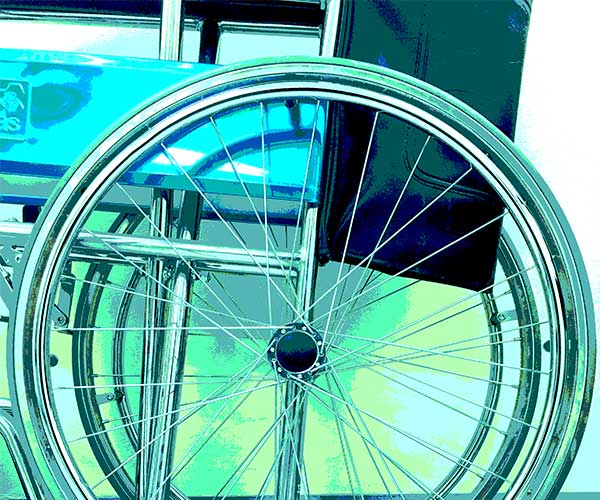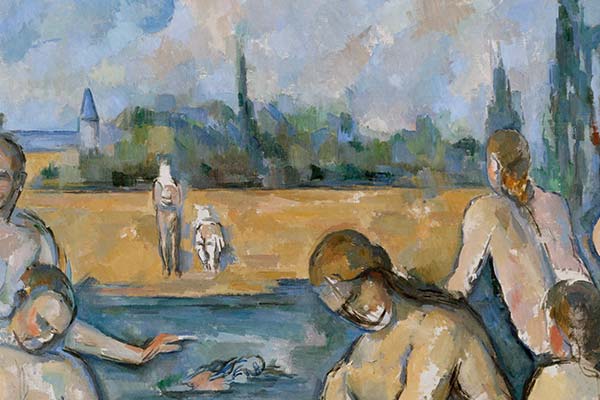Subtotal: $
Checkout
The Effort in the Image
On seeing Cézanne’s The Large Bathers from a rented wheelchair
By Victoria Reynolds Farmer
August 10, 2020
In the days before my first-ever trip to London, many friends and acquaintances asked me if I was excited to go. I responded that I was, but I also said that I was apprehensive about how it would feel to be physically confronted with buildings and spaces and art that I had spent so much of my life studying. “There’s a part of my brain that thinks these things don’t actually exist,” I said, over and over, “so seeing them might be kind of surreal.”
When my husband and I were planning our itinerary, he added very few things. This trip was mostly mine – a celebration of our having finally paid off the loans incurred on the way to my earning a doctorate in literature focused on the drama of the British Renaissance. Since I was picking most of the things we did and saw, I didn’t feel right questioning the one thing he really wanted to experience while on our trip: dinner at Dans le Noir?, a restaurant where you eat, as its name suggests, entirely in the dark. He had heard a musician he likes mention eating there years before and wanted to visit ever since. There are only six of these restaurants in the world, and who knew when we would have the opportunity (or the budget) again?
All perfectly reasonable, and yet I was still deeply hesitant. As someone with spastic diplegic cerebral palsy, I don’t do a great job at walking in crowded restaurants when I can see where I’m going, much less in total darkness. I called the restaurant in advance to ask about accessibility, and was reassured that I would be well taken care of. Even so, I still wondered about the walk from the restaurant’s lit antechamber into the dark dining room. When reading reviews, I noted that this walk is typically performed while putting one’s hand on the shoulder of another diner and walking slowly – as if in a sort of conga line – to the table. Walking in the dark while touching strangers was not something I looked forward to.
They are all artifacts of the same miraculous creation – trees and bodies alike are reflections of the imago dei in the world.
The evening of our dinner reservation came. We placed our phones in the provided lockers and ordered our meals from the color-coded menus. Instead of choosing from a list of dishes, you pick a color: red for red meat, blue for seafood, or green for vegetarian. In order to force you to use your senses of taste and smell in the absence of sight, you don’t know what you have eaten until the meal is over. Once we chose our menus, it was time to face my fear. We lined up with the six other couples who were seated at our table. I was behind a man named Emanuel who was there celebrating his girlfriend’s birthday. I placed my right hand on his right shoulder, as instructed. Our server, Nadeen, was at the head of the line. Like all servers at Dans le Noir, she was blind.
I was heartened by the restaurant’s commitment to inclusion, which is in keeping with the social model of disability. As opposed to the medical model, which frames disability as something to be overcome by the disabled person individually, the social model places the onus of change on society. It does not view disability as an inherently negative state of existence, but rather holds that disabled people can positively experience the world in a way others do not. Dans le Noir’s waitstaff are especially suited to navigating the restaurant due to the work they have already done to adapt to a seeing world.

As a sighted person, I found that I had to reinterpret my own experiences with disability in that context. There were two distinct moments during our dinner that troubled me. I was surprised at how difficult it was for me to judge the distance from my plate to my mouth; I stabbed myself with my fork a few times, struggling to stay silent and hide that I was having trouble. Meanwhile, one woman announced that she was just going to eat with her hands because no one could see her anyway. While her comment momentarily made me feel better about my own fork situation, I quickly shifted from being comforted to being frustrated. It seemed like a luxury that she could just decide to do that without being judged, free of the pressure that disabled people often feel not to stand out, not to be a burden, not to take up too much space. I became determined to learn to use my fork in the dark.
The second thing that gave me pause was a joke that Nadeen made during dinner, one that she had obviously made many times before. When a couple told her that they were there on a blind date, she quickly responded, “Every date is a blind date for me!” I laughed along with the rest of the table, but I was disoriented by what I couldn’t do – connect with Nadeen in a way that showed I understood the need to make the joke first, before someone does it at our expense. In this circumstance, I was passing as an able-bodied person, and that was a huge reframing of a central facet of my identity relative to those around me.
While in London, more than anything, I wanted to see Paul Cézanne’s The Large Bathers in the National Gallery. Since I can remember, I have preferred the work of the post-Impressionists to all other styles of painting. The first piece of art I ever called my favorite was Vincent van Gogh’s Starry Night. I remember telling my father how much I enjoyed the painting, and then coming home a few weeks later to find a huge framed reproduction hanging over my bed. Today, it hangs in my dining room, and I’ll keep it for as long as I have a home to decorate. I know now that loving that painting isn’t cool or high-class; it’s the province of tote bags and umbrellas and coffee mugs, the sort of art that people who don’t really know much about art enjoy. For me, though, that painting will always be about feeling truly seen by my father – he had listened actively during a conversation about something I enjoyed, and then he spent the time and money it took to purchase it for me for no specific occasion or reason other than the fact that it would make me happy.
While that emotional moment probably catalyzed my love for the post-Impressionists, the paintings themselves enriched and continued it. There’s something about the paint on the canvas that connotes all the work that goes into the creation of a beautiful piece of art. Up close you can see the brushstrokes, and in some cases, the texture of multiple layers of paint as colors have been mixed. Here is the evidence that this beautiful thing was made by a person. Someone made decisions about color palettes and techniques. The painter probably got frustrated at one point or another, maybe even letting a few swear words slip out during the process.
“It looks the way that moving without effort must feel.”
These clues to the work that went into the art run counter to the idea that if you’re a really talented artist, your effort should not be apparent to observers. Art theorists call this concept sprezzatura, a studied carelessness or nonchalance. The word first appears in a 1528 text by Baldassare Castiglione called The Book of the Courtier, which was important to court culture in Renaissance England because it laid out a lot of rules that were instrumental to getting and maintaining the right kind of reputation as a courtier. Like sprezzatura, a number of these rules center around creating an ethos of effortlessness that itself takes a great deal of effort to construct. There are tips on how to choose clothes that are becoming, but not too showy, advice on how to praise oneself in public, but not too much.
I’ve always been a little annoyed with this book, and with sprezzatura more specifically. I am not a person who can really hide the effort it takes me to move around in the world. When I walk down the street, people stare. Children point and whisper. Sometimes they even turn their heads backward to keep looking at me as I pass. Once, a child doing this lost his balance and fell down, and I’d be lying if I said I didn’t relish this poetic justice just a bit.

Paul Cézanne, The Large Bathers, detail Image public domain
I don’t remember the first time I saw Cézanne’s The Large Bathers. Maybe it was during the overview of how different artists interpreted bodies in art camp the summer after sixth grade. Maybe it was during a college art history seminar, or flipping through art books during a boring stretch volunteering in my hometown library. Whenever it happened, I do know that that painting sticks out as the culmination of my fascination with the visible effort of the post-Impressionists. There’s just something about the combination of cool, calming colors and the way that the thick, curved brushstrokes unify the unabashedly nude, undeniably beautiful bodies of the bathers with the shrubs and trees behind them. They are all artifacts of the same miraculous creation – trees and bodies alike are reflections of the imago dei in the world.
To get to the original, I had rented a wheelchair. While I generally get around without aids, vacations require a lot more walking than everyday life, so I decided to use a chair while sightseeing. London, an old city, was not built with accessibility in mind. My husband spent lots of time lugging the wheelchair up and down Tube station steps as I walked behind him. On one excursion, we were forced to wait for a second city bus because each bus can only accommodate one wheelchair user at a time. I felt betrayed by a place I had wanted to be in for so long.
At the National Gallery, I sat in front of the painting for several minutes, taking it in, trying not to think about the way my chair was blocking other museum patrons. “It looks the way that moving without effort must feel,” I said. “That’s really sad and beautiful,” my husband replied. It was the first time I had ever put my love for the painting into words, and I realized that I loved it because it let effort and smoothness coexist in a way I didn’t feel I ever could. Sitting there, in the middle of the city that I had loved from afar for so long, a city that didn’t seem built for my existence in the world, I began to think about my life inside my body. I thought about all the ways I’ve struggled to let this body belong to a conception of the imago dei the way that Cézanne’s bathers belong with the trees because they have the same brushstrokes.
I cried for the way Christ’s incarnational crucified body and miraculous resurrection make it impossible to separate beauty from pain.
I remembered the jolt of pain and unworthiness I felt as a child every time my congregation sang “Take My Life and Let It Be,” because my feet would never be swift or beautiful, not for God or anyone. I remembered the shame and embarrassment I felt every time a stranger stopped me on the street and asked to pray for God to heal my disability, never pausing to ask whether that’s what I wanted. I remembered the joy and wonder I felt during one mass at St. Gabriel’s near our home in Minnesota, when I realized that all the aisles were ramps and one of the Eucharistic servers used a wheelchair, and no one ever remarked on it; he was just a part of Christ’s body, serving as he could in a space made for all its members.
I bought a postcard of The Large Bathers for a pound sterling. I cried on the Tube back to our hotel – for myself, for my dinner companion eating with her hands, for the wheelchair-using Eucharistic minister, for the way Christ’s incarnational crucified body and miraculous resurrection make it impossible to separate beauty from pain. The station didn’t have a lift, of course.
Already a subscriber? Sign in
Try 3 months of unlimited access. Start your FREE TRIAL today. Cancel anytime.







Sheila DeCosse
This is such a beautiful honest "memoir." Thank you.